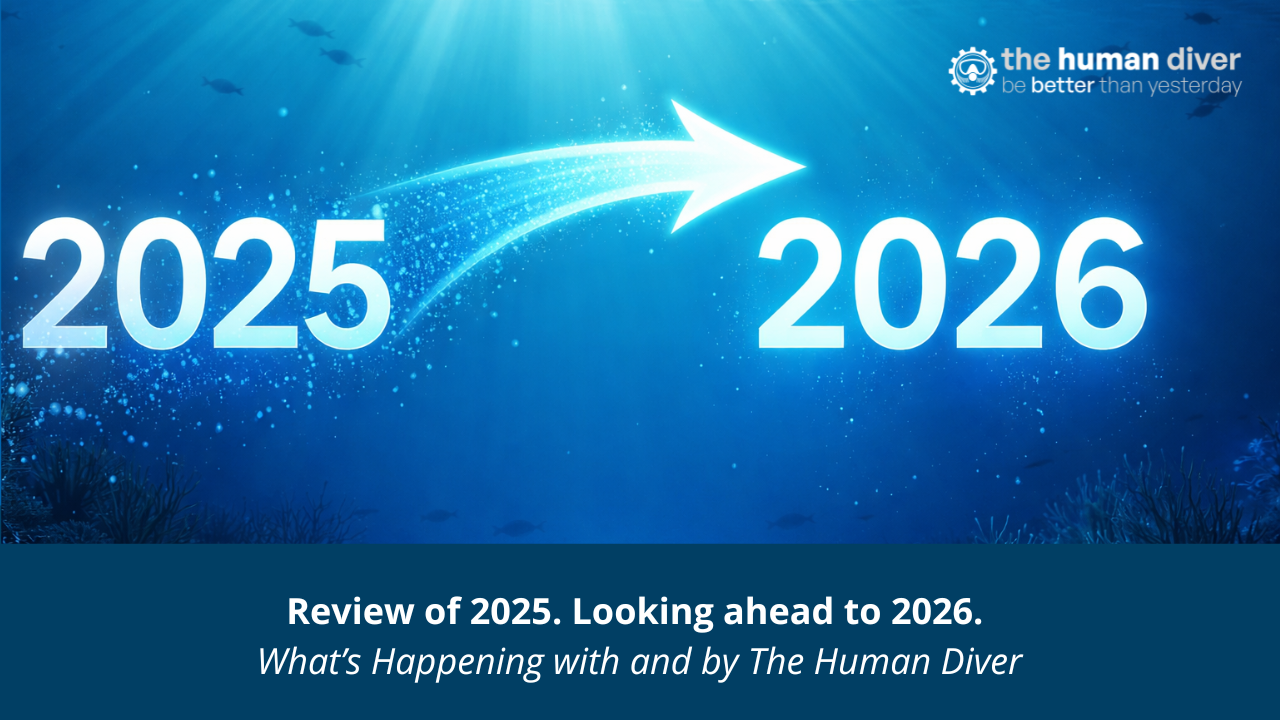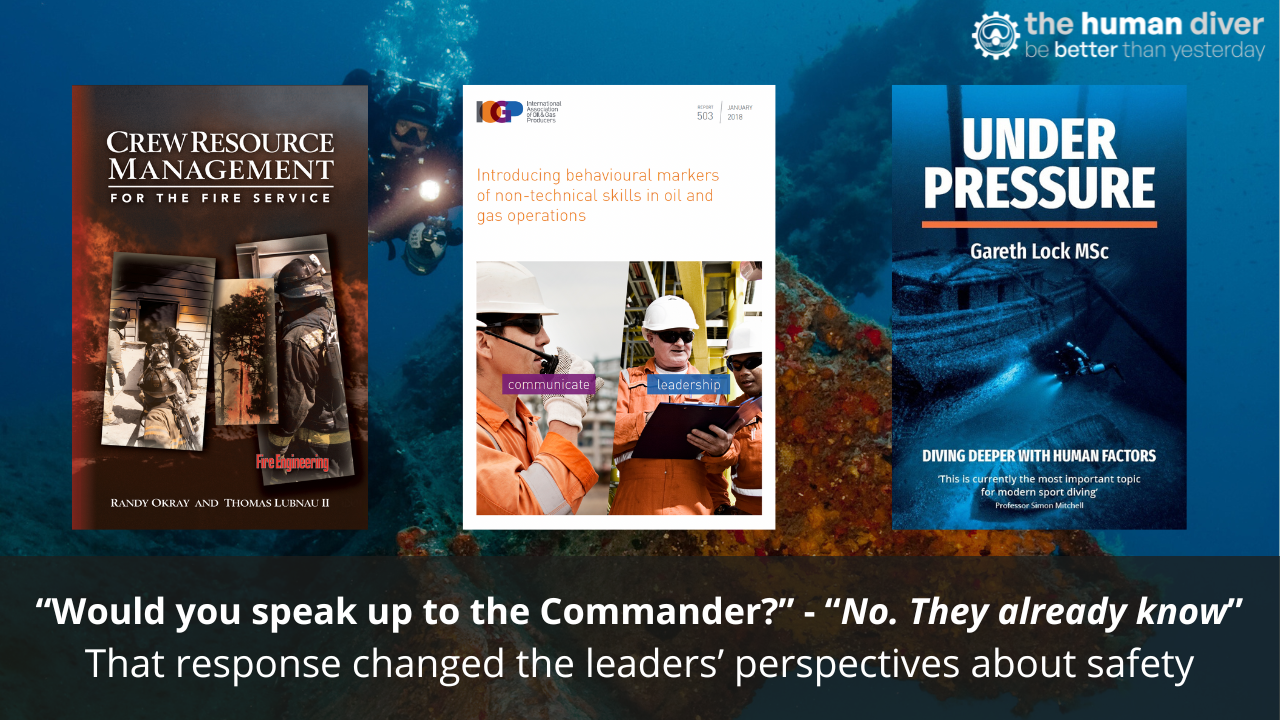
Why is it so hard to create a team quickly in diving, especially in classes? #1
Jan 11, 2021I recently had a conversation with an experienced recreational instructor and technical instructor about how to include the human factors and non-technical skills training I had delivered to them in their own training and the wider diving community. One of the key challenges was how do you take a group of students in a class and create a team quickly? This isn’t the first time I have heard this. The research has shown that one of the quickest ways to do this is for the leaders to show vulnerability, talk about mistakes or issues they have had in a recent task or project, or to say that they don’t know the answer and ask the team for advice.
A valid point that this instructor made was the litigious nature of diving, especially in the US, which makes it incredibly difficult to create that vulnerability. If an instructor identifies something that didn’t go to plan or deviated from standards to their students (for whatever reason), then they are opening themselves up for litigation or to a standards check from the agency they are working with. The former is incredibly expensive and time-consuming, so there is a strong tendency to teach defensively and if anything goes wrong, then it is not discussed in a manner which allows learning or is hidden. Many agencies consider it a breach of standards if one instructor doesn’t report another for a breach of standards! Nothing like keeping quiet…Unfortunately, as this instructor highlighted, perception is reality as far as many dive professionals are concerned as so they are unlikely to change their position.
As a consequence of this conversation, I decided to write a four-part blog which looks at how you can create psychological safety within your team using the latest research that is out there. Note, that every instructional dive is a team dive. The instructor is the leader, and the student(s) are the followers. Both instructor and student are operating around a common purpose – learning. The students learning from the instructor and other students in the class, and the instructor is learning from the execution of the class. Or they should be because every class provides a learning opportunity. An opportunity where you can improve yourself by seeing how your training was received, how it improved your students and how it improved your teaching.

In 2020, Dr Timothy Clark published a book which built on the work of Edgar Schein and Professor Amy Edmondson, considered world leaders in the fields of organisational culture and psychological safety respectively. Amy Edmondson in her work from the late 1990s and early 2000s defined psychological safety as the “shared belief within the team that it was ok to take an interpersonal risk” and that “a team member will engage in subconscious decision-making, weighing up the risk of speaking up against the interpersonal climate versus the longer-term consequences of not speaking up”.
This latter point highlights the point that as a team member if I speak up now, the response from the team or leader will be immediate and could be negative, whereas if I choose to stay quiet, the response will be delayed, and the issue might go away. Human nature means that we prefer to avoid immediate negative responses if there is a possibility of a gain in the future (prospect theory).

Clark’s research which went into the book ‘The Four Stages of Psychological Safety’ took Edmondson’s concepts further and showed that psychological safety is created over four stages: inclusion safety, learning safety, contributor safety and challenger safety. The latter is the one we often focus on in diving, where anyone can thumb a dive at any time for any reason or be able to speak and stop something which appears to be unsafe. What Clark showed was that unless the lower levels of psychological safety were present, you can’t get to the higher levels.
Each blog will cover one of Clark’s four stages.
Part One: Inclusion Safety (this article)
Part Three: Contributor Safety
The ideas and concepts within this series are based on the training materials from Leadership Factor where I am a certified trainer and consultant for the ‘Four Stages of Psychological Safety’. They have been adapted to be applicable in the diving environment, especially the diver training environment. Each blog contains five tips/tools which you can apply to your own diving/instruction.
INCLUSION SAFETY - How do you make others feel included?
The first step in terms of creating a team and building psychological safety is to create inclusion safety. There can be some serious barriers to achieving this in diving with agency allegiances, equipment configurations, ‘titles’ or ‘badges of honour’ getting in the way. Ultimately, we have a real want to ‘belong’ to a group. We are social creatures at heart and inclusion is really important.
Move to mutual discovery quickly
Ask your team members or students questions to discover their personal interests and find common ground. In a class, you could even do this before the class via email to find out what their interests are and what their goals for the class might be. To help you with these questions, you might want to write them down before you engage in a conversation during class – the more you practice, the easier it becomes. Once you move out of the ‘standard’ mode of platitudes and pleasantries into mutual discovery, the relationship-building accelerates. Don’t probe into personal or sensitive topics though, just ask some natural questions about background and interests.

Define and communicate the purpose and values of your team.
To feel a part of the team, the individual must understand why the team exists, how it works, and what it stands for. The team must first define its values, purpose, and goals and continuously communicate those things to team members. For an instructional setting, this could be about defining your values as the instructor and setting expectations and performance criteria. Maybe something about why you teach and what it means to you personally. In terms of diving in a team of ‘fun divers’ – what makes you tick and why do you do the diving you do.
Listen and pause.
Listen with the intent to comprehend rather than the intent to respond – this is sometimes known active listening. You do this by listening, pausing to reflect, and then responding thoughtfully and linking to what has just been said. Have you ever been talking to someone and you can tell that they’re simply waiting for you to finish your sentence so they can jump in? That’s not always a problem, but if that’s the pattern, it does become a problem, especially if there is critical information being passed on.

Follow through on small commitments.
If you make a commitment, follow it through, especially if it’s a small one. Sweating the small stuff is an expression that you respect and value others. This could be following up on some guidance after a class, or fixing something for someone, or returning something that was loaned to you.
Forbid personal attacks.
People make mistakes, fail, and often get things wrong. But they are still entitled to respect and the permission to participate. There is never a justification for a personal attack. Call out even marginal comments or behaviours that could make a person feel marginalised or disrespected. This isn’t just the instructor or those in leadership positions that should do this, it is everyone in the team. Furthermore, if one of the team members calls out such behaviour, the leader/instructor needs to congratulate this challenge to reinforce what is unacceptable behaviour.

Inclusion safety is normal for small kids, but as we grow and become more self-aware, we form groups and cliques. We shun others. We ignore others. However, if we want to create inclusion safety, we must start to practice inclusion. Break the barriers down and have fun.

Gareth Lock is the owner of The Human Diver, a niche company focused on educating and developing divers, instructors and related teams to be high-performing. If you'd like to deepen your diving experience, consider taking the online introduction course which will change your attitude towards diving because safety is your perception, visit the website.
Want to learn more about this article or have questions? Contact us.











